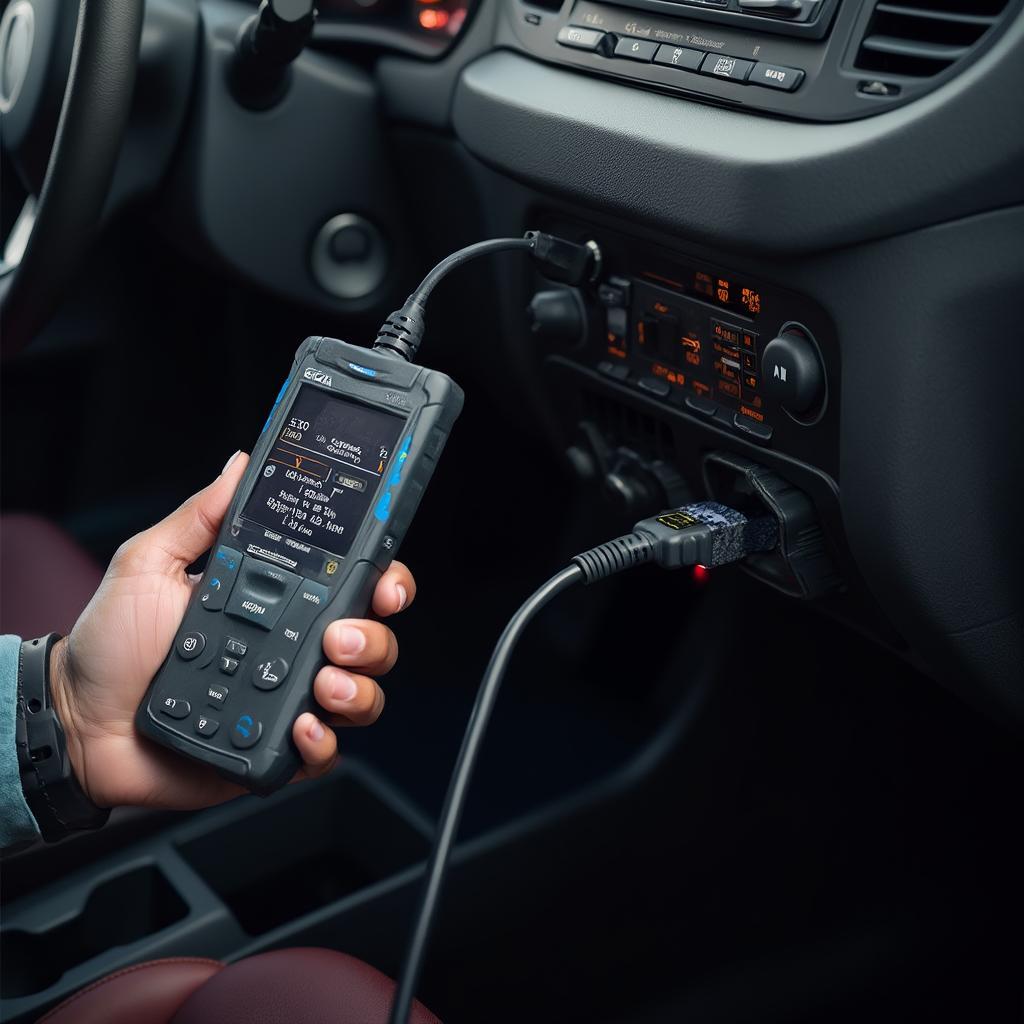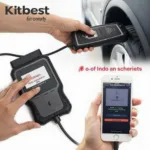OBD2 information is crucial for understanding your vehicle’s health and performance. This comprehensive guide dives deep into everything you need to know about OBD2, from its basic functionality to advanced diagnostics. We’ll explore how this technology empowers car owners and professionals alike.
Understanding OBD2 information starts with knowing what OBD2 stands for: On-Board Diagnostics, generation two. This standardized system allows external devices, like OBD2 scanners, to access a vehicle’s internal computer and retrieve valuable data. This data can range from simple diagnostics like check engine light triggers to more complex information like fuel efficiency and emissions data. This information is vital for troubleshooting, maintenance, and even enhancing performance.  OBD2 Scanner Connected to a Car's Diagnostic Port
OBD2 Scanner Connected to a Car's Diagnostic Port
What OBD2 Information Can You Access?
OBD2 information provides a wealth of data about your car’s systems. It’s like having a direct line to your vehicle’s brain, providing insights into its inner workings. Some key data points include:
- Diagnostic Trouble Codes (DTCs): These codes pinpoint specific issues within your vehicle’s systems.
- Freeze Frame Data: This snapshot of the vehicle’s status when a DTC is triggered helps diagnose intermittent problems.
- Sensor Data: Real-time readings from various sensors provide insights into engine performance, fuel efficiency, and emissions.
- Vehicle Speed: Monitor your vehicle’s speed directly from the OBD2 port.
- Engine RPM: Track engine revolutions per minute for performance monitoring.
- Coolant Temperature: Keep an eye on engine temperature to prevent overheating.
obd2 information display offers a clear and concise overview of the different types of data that can be accessed. Understanding these parameters empowers you to make informed decisions about your vehicle’s maintenance and repair.
How to Use OBD2 Information Effectively
Knowing how to interpret and utilize OBD2 information is crucial. Simply reading the data isn’t enough; you need to understand its implications.
- Identify the Problem: DTCs provide a starting point for diagnosing issues. Use reliable resources like online databases and repair manuals to decode these codes.
- Analyze Sensor Data: Look for patterns and deviations from normal values to pinpoint potential problems.
- Monitor Performance: Track fuel efficiency, emissions, and other parameters to assess your vehicle’s overall health.
Advanced OBD2 Information and Diagnostics
Beyond basic diagnostics, OBD2 information can be used for advanced analysis and performance tuning. obd2 情報 種類 explores the different categories of information available, ranging from basic diagnostics to advanced performance data. This opens doors for:
- Performance Tuning: Monitor and adjust various parameters to optimize engine performance and fuel efficiency.
- Predictive Maintenance: Analyze trends in sensor data to predict potential problems before they occur.
- Emissions Monitoring: Track emissions levels to ensure compliance with environmental regulations.
“Understanding OBD2 data is like having x-ray vision into your car’s health,” says John Davis, a certified automotive technician with over 20 years of experience. “It allows you to diagnose problems accurately and efficiently, saving you time and money.”
OBD2 Information for Different Vehicle Types
OBD2 is a standardized system, but there can be slight variations depending on the vehicle’s make, model, and year. obd2 取得 できる 情報 provides specific information on the types of data retrievable from different vehicle models. It’s essential to consult your vehicle’s documentation or a reliable OBD2 resource to understand the specific parameters available for your car.
The Future of OBD2 Information
The landscape of OBD2 information is constantly evolving. With advancements in technology, we can expect even more sophisticated diagnostics and data analysis capabilities in the future. This will empower car owners and professionals with even greater insights into vehicle health and performance.
obd2 정보 offers a glimpse into the future of OBD2 technology, including its potential integration with connected car platforms and smart devices.
Conclusion
OBD2 information is a powerful tool for anyone who owns or works with vehicles. By understanding how to access, interpret, and utilize this data, you can take control of your vehicle’s maintenance, diagnose problems efficiently, and even enhance performance. Mastering OBD2 information is key to keeping your car running smoothly and maximizing its lifespan.
obd2 wireless vehicle information system provides detailed information about the latest advancements in wireless OBD2 systems, allowing you to access data remotely.
FAQ
- What is OBD2? OBD2 stands for On-Board Diagnostics, generation two, and it’s a standardized system for accessing vehicle diagnostic information.
- Where is the OBD2 port located? The OBD2 port is typically located under the dashboard on the driver’s side.
- What can I do with OBD2 information? You can diagnose problems, monitor performance, and even enhance your vehicle’s performance.
- Do I need a special scanner to access OBD2 information? Yes, you need an OBD2 scanner to retrieve the data from the port.
- Are all OBD2 scanners the same? No, there are various types of OBD2 scanners with different features and capabilities.
- Is OBD2 information difficult to understand? While some data may require technical knowledge, many resources are available to help you interpret the information.
- Can I damage my car by using an OBD2 scanner? Using an OBD2 scanner correctly poses no risk to your vehicle.
“Utilizing OBD2 data allows for proactive maintenance, preventing costly repairs down the line,” adds Susan Miller, an automotive engineer specializing in vehicle diagnostics.
For further assistance, please contact us via WhatsApp: +1(641)206-8880, Email: [email protected] or visit our office at 789 Elm Street, San Francisco, CA 94102, USA. Our customer service team is available 24/7.
